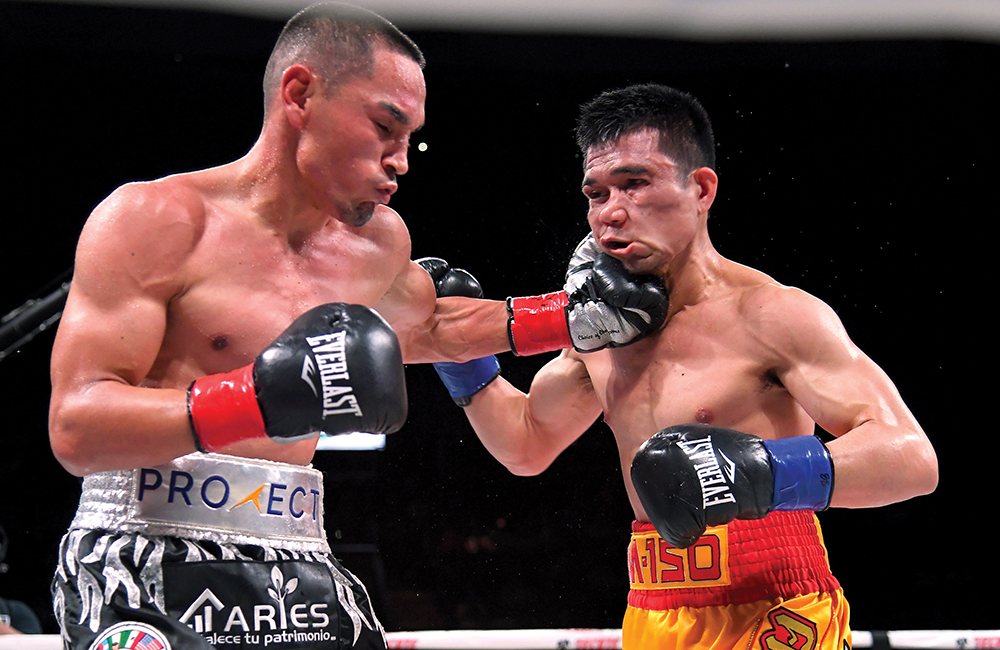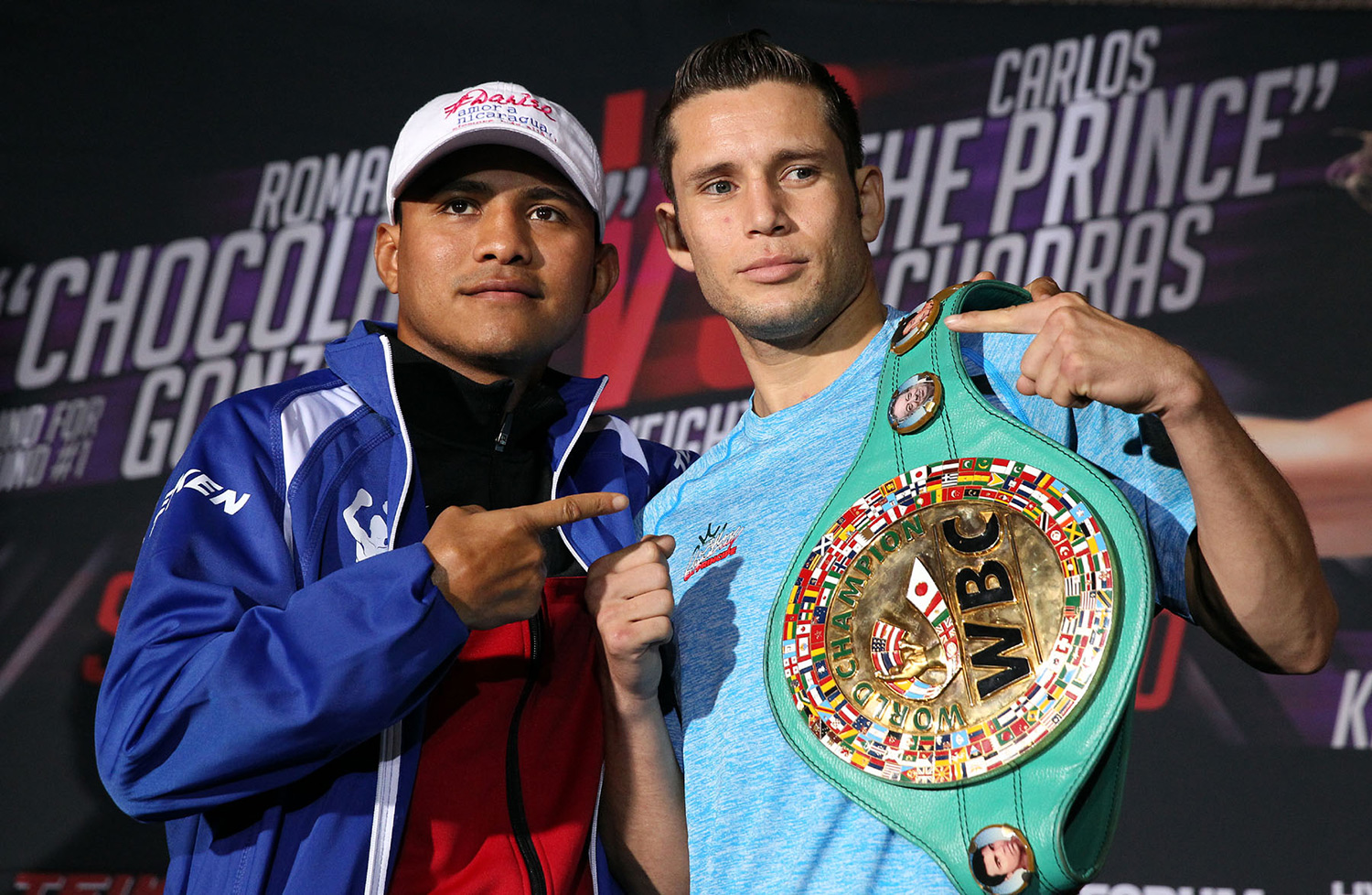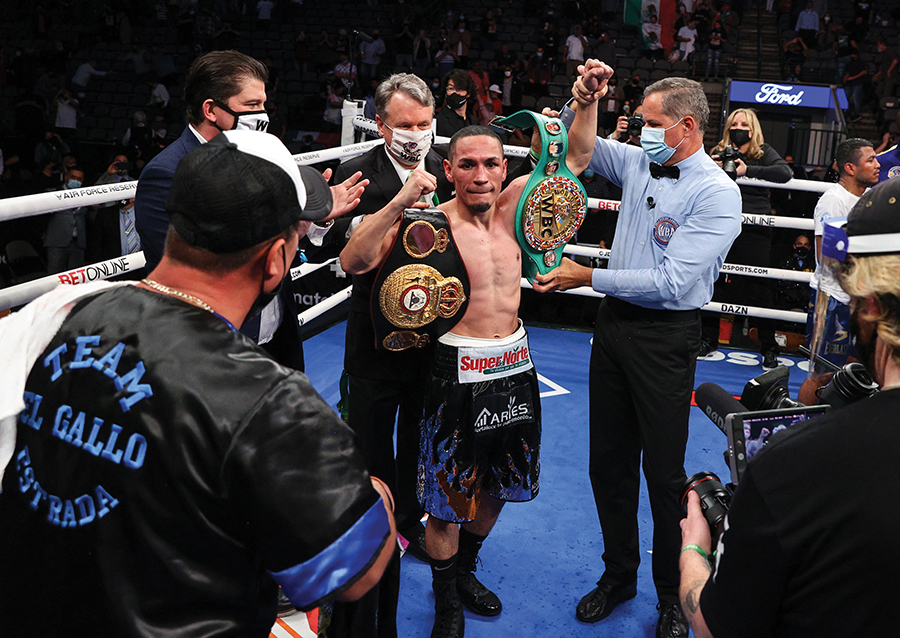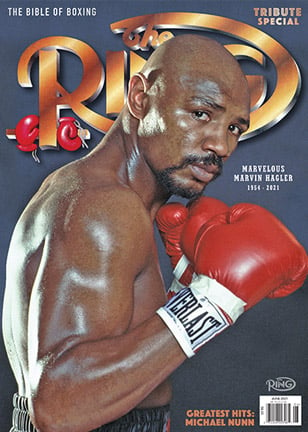
THE EPIC ROUND ROBIN THAT BEGAN WITH THE FIRST ROMAN GONZALEZ-JUAN FRANCISCO ESTRADA FIGHT CONTINUES (BUT WILL NOT END) WITH THEIR RUBBER MATCH
Eddie Hearn is as prone to hyperbole as the next promoter, but not even his most ardent detractors faulted him for tweeting that the rematch between Juan Francisco Estrada and Roman Gonzalez was the best fight he’d ever seen.
While Boxing Twitter reverberated with awe in the moments after the final bell for the Ring/WBC/WBA junior bantamweight championship, Hearn carried his euphoria into the brief post-fight press conference where he was joined by Estrada, who had just avenged his 2012 loss to Gonzalez with a split decision victory.
Gonzalez, who many believed deserved to win the early Fight of the Year candidate, did not attend the presser, but his management let the intrepid British promoter know that he was game for a rubber match.
Hearn was still wonderstruck by the rematch.
“That was the greatest fight I have ever watched live,” said Hearn, whose Matchroom Boxing promoted Anthony Joshua-Wladimir Klitschko, Josh Taylor-Regis Prograis and Carl Froch-George Groves I and II, among other major events and modern classics. “In 33 years of watching boxing, it’s the best I’ve ever seen.”
Hearn isn’t alone in that sentiment. Hardcore fans know that a rare brand of boxing magic transpires whenever Estrada and Gonzalez share the ring, and they want another encore. They had to wait more than eight years for the rematch, but the rubber match could come together by the end of summer, according to Hearn, who would love to stage it at a packed Dignity Sports Health Park (formerly StubHub Center) in Carson, California, once COVID-19 crowd restrictions are lifted.
Whoever prevails in the third chapter of their rivalry won’t have much time to savor the victory, as the winner is supposed to immediately face the winner of a rematch between Srisaket Sor Rungvisai and Carlos Cuadras (familiar foes of both Estrada and Gonzalez), per an agreement with the WBC.
At the start of the year, it was believed that the winner of the Estrada-Gonzalez rematch would have to immediately face Sor Rungvisai, the WBC’s long-standing mandatory challenger. The former champion from Thailand has been patiently waiting for another crack at the WBC title since losing the green belt (and the Ring title) to Estrada in 2019.

Estrada clocks Sor Rungvisai during their rematch in 2019. (Photo by Jayne Kamin-Oncea/ Getty Images)
However, the WBC realizes what Hearn explained to the small gathering of media at the post-fight conference: that the money is with Estrada-Gonzalez III, not Estrada-Sor Rungvisai III.
“I paid [Avni] Yildirim more [for his WBC-mandated non-effort against Canelo Alvarez] than Juan Estrada [made for the Gonzalez rematch], and it makes me feel a little bit sick,” Hearn said. “I watch [the Estrada-Gonzalez rematch] and I think those guys should get more. But [boxing] is not a charity. It’s a business. So, it depends on how many people want to watch the fight. More people want to see the third fight [with Gonzalez].
“The money that a fight generates reflects on the purse that a fighter is paid. It doesn’t matter about their weight class, sex or race, it matters about subscriptions, tickets sales, commercial interest from broadcasters. I don’t know what Estrada made for the first fight, but I’d like to think he made 10 times more, tonight, for the second fight. And I’m sure his manager will be asking for more for the third fight. Mucho dinero!”
That’s something the WBC understands, and they’re better at looking at the long game than the other sanctioning organizations, which is why in late March, Estrada was “elevated” to “Franchise champion” status – a political designation previously bestowed upon Canelo and Vasiliy Lomachenko to aid the pound-for-pound players in avoiding WBC mandatories that were not in public demand – and an immediate third bout with Gonzalez was approved.
To placate Sor Rungvisai, who had already stepped aside to allow the Estrada-Gonzalez rematch, the WBC sanctioned a rematch between the Thai veteran and Cuadras for their now-vacant 115-pound world title and mandated that the winners of Estrada-Gonzalez III and Sor Rungvisai-Cuadras II fight each other.

Sor Rungvisai stunned the boxing world with a fourth-round knockout of Gonzalez in 2017. (AP Photo/ Chris Carlson)
The Mexico City-based sanctioning body is calling it a “tournament,” but they needn’t be so formal. These junior bantamweights have a penchant for tough challenges, and you may have noticed they have history.
Gonzalez (50-3, 41 KOs) has fought Cuadras once, and Estrada and Sor Rungvisai twice each. Estrada (42-3, 28 KOs) has fought Cuadras, Sor Rungvisai and Gonzalez twice each.
The 10-bout series between Gonzalez, Estrada, Sor Rungvisai and Cuadras is arguably the closest rivalry this era of boxing has to the celebrated nine-bout round robin between the Four Kings – Marvin Hagler, Sugar Ray Leonard, Thomas Hearns and Roberto Duran – during the 1980s.
The 115-pounders are accomplished, battle-tested veterans who fight with the style and mentalities of the Four Kings and other elite-level boxers of the ’80s – displaying complete craft without sacrificing aggression for defense and technique.
And while nowhere near as famous as their larger 1980s counterparts, the quartet has done their part to shine a light on sub-bantamweight divisions with the help of promoter Tom Loeffler, who paired Gonzalez with Gennadiy Golovkin from 2015 to 2018 and originated the “SuperFly” series, garnering HBO exposure for Chocolatito and his 115-pound rivals.

Cuadras defeated Sor Rungvisai in 2014 but would suffer his first loss at the hands of Chocolatito in 2016. (Photo by Chris Farina / K2 Promotions)
For those keeping score, the Little Kings’ round robin began November 17, 2012, with the only bout of the series not contested at junior bantamweight, Gonzalez’s WBA 108-pound title defense against Estrada. The 22-year-old challenger from Sonora, Mexico, exhibited skill, savvy and durability that suggested championship potential, but the prime version of Gonzalez was an unstoppable force and the Nicaraguan’s signature pressure and volume punching secured a unanimous decision.
Estrada, who seized the WBA and WBO flyweight belts from Brian Viloria less than five months after the loss, began beating the drums for a Gonzalez rematch.
“El Gallo always had a desire to avenge his losses,” said Juan Hernandez, president of Latin Sports, which has represented Estrada since his pro debut and currently co-promotes the Mexican standout with Zanfer and Matchroom.
“When he became flyweight champion, he felt he could beat Gonzalez if they fought at 112 pounds. He always told the Mexican media the fight he wanted the most was Gonzalez, especially when Gonzalez moved up to the flyweight division.”
Gonzalez stopped Akira Yaegashi in nine rounds, earning The Ring and WBC flyweight titles in September 2014. Four months earlier, Cuadras lifted the WBC 115-pound title from Sor Rungvisai via narrow eight-round technical decision. The unbeaten Sinaloa native took an early lead with fast flurries and fleet feet, but the defending beltholder’s relentless pressure closed the gap on the scorecards by the middle rounds. A clash of heads in Round 8 produced a cut over Cuadras’ left eye that sent the bout to the scorecards when it seemed like Sor Rungvisai was beginning to take over.
Gonzalez and Estrada defended their 112-pound titles in 2014 and 2015, chopping down former champs Viloria, Giovani Segura, Hernan Marquez and Edgar Sosa, but they couldn’t reach terms to face each other in what would have been a glorious flyweight unification showdown.
In September 2016, Gonzalez supported his pound-for-pound credentials by challenging Cuadras in an attempt to become the first Nicaraguan to win a world title in a fourth weight class (junior bantamweight). He accomplished his goal with a hard-fought unanimous decision but also inherited Cuadras’ long-festering WBC mandatory, Sor Rungvisai.
The rugged former titleholder got his shot in March 2017, and in one of the greatest victories in Thai boxing history, Sor Rungvisai handed Gonzalez his first pro loss, narrowly outpointing the pound-for-pound king in a brutal battle of attrition.
The WBC realizes what Hearn explained to the small gathering of media at the post-fight conference: that the money is with Estrada-Gonzalez III, not Estrada-Sor Rungvisai III.
Gonzalez, whose trainer and father figure, Arnulfo Obando, died shortly after the Cuadras victory, entered the immediate rematch in September looking like a shell of his former self, a shell that Sor Rungvisai ruthlessly shattered in four rounds. On the undercard of Sor Rungvisai-Gonzalez II (the main event of the inaugural “SuperFly” promotion), Estrada scored a razor-thin unanimous decision (thanks to scoring a 10th-round knockdown) over Cuadras to earn a shot at the Thai conqueror, who turned back the Mexican’s bold challenge with a majority decision in 2018 (an exhibition of controlled aggression that earned Sor Rungvisai the vacant Ring title).
However, Estrada gained revenge (and the Ring and WBC belts) by scoring a competitive unanimous decision in their April 2019 rematch. Now a two-division champion, and finally cracking pound-for-pound rankings, Estrada kept his eye on the ultimate prize.
“As time went on, Juan’s appetite for Gonzalez grew,” Hernandez told The Ring. “After he beat Sor Rungvisai, you could say Chocolatito became his obsession, his final loss to avenge.”
But Gonzalez, who was written off by most of the boxing world following the KO loss to Sor Rungvisai, would first have to fill the void left by Obando’s passing and then pull himself back into world-class status. He accomplished this, first by uniting with Marcos Caballero, who would become Gonzalez’s new coach and trusted mentor, and then by upsetting unbeaten Kal Yafai for the WBA title in February 2020.
The stars were almost aligned for the dream rematch, but Estrada still had a few hurdles to clear – an October rematch with Cuadras, which produced one of the best fights of 2020 as the Mexican veterans traded knockdowns and vicious exchanges before El Gallo prevailed by 11th-round stoppage, and the lingering obligation of the WBC’s perennial mandatory challenger.
In December, Sor Rungvisai agreed to prolong his shot at the green belt by allowing Estrada-Gonzalez II to take place in early 2021 (providing he’d get an immediate shot at the winner).
Expectations for the rematch were high, as they should have been. Estrada is pound-for-pound ranked and Gonzalez is already considered a future first-ballot Hall of Famer, and despite considerable wear and tear from multi-divisional title reigns, the two exceeded their first encounter and any of their previous ring wars.
On the same day the world learned of Hagler’s untimely passing, Estrada and Gonzalez dug deep for 12 unforgettable rounds and gave the former middleweight champion a proper tribute that transcended any words that fans or media could hope to muster in their shock and grief.
For 36 breathtaking minutes, Estrada and Gonzalez exhibited what boxing is at its best: the most thrilling and dramatic of all professional sports. The back-and-forth action was almost too fast to follow but conducted on the highest technical level. The pace was beyond frenetic as they combined to throw a division-record 2,529 punches, according to CompuBox.

To the victor goes the spoils, but Estrada and Gonzalez will throw down again in 2021. (Photo by Ed Mulholland/Matchroom)
Clinches? They didn’t need any stinking clinches. Backpedaling? Please. Estrada and Gonzalez know how to fight, and both carried Hagler’s creed of “Destruction and Destroy” into this long-overdue showdown. One could imagine the war master solemnly nodding his shaven head in approval from Boxing Valhalla as they pushed themselves past human limits in Rounds 6, 7 and an epic 12th. Hagler’s spirit was alive inside the American Airlines Center that night.
Scorecards without controversy would have been asking for too much – the 115-113 tallies for each warrior were indicative of what transpired; a draw would have been poetic – but Carlos Sucre’s 117-111 card for Estrada was a rude reminder that boxing is as much a poorly run business as it is sport.
That sad fact is one of the few things that hasn’t changed since Hagler’s era, but most of what made boxing mainstream in previous decades – great champions clashing to create great fights – seems gone forever.
However, the junior bantamweight division reflects boxing’s glory years despite being under the radar of casual American fans and media. Estrada and Gonzalez want to make money, but they also want to test their mettle against their worthy peers, not just each other. Both have stated the goal of unifying the major titles – held by Kazuto Ioka (WBO) and Jerwin Ancajas (IBF) – once their score and WBC obligations have been settled.
Hardcore fans lamenting Hagler’s passing, or the gradual demise of boxing’s popularity, can rejoice in Estrada, Gonzalez, Sor Rungvisai and Cuadras, whose competitive natures transcend business and politics as usual.
They’ve given us some gems over the past nine years. For all we know, the best is yet to come.
And that ain’t hyperbole.

A KING TAKES AIM

Photo by TLAROCK
If Juan Francisco Estrada, Roman Gonzalez, Srisaket Sor Rungvisai and Carlos Caudras are the new Four Kings of boxing, perhaps Kazuto Ioka can become the “fifth king,” as Wilfred Benitez was to three members of the iconic quartet of the 1980s, if he’s given the opportunity. The four-division titleholder from Japan, who possesses the WBO 115-pound belt, cracked the pound-for-pound rankings with an eighth-round stoppage of Kosei Tanaka on New Year’s Eve. Ioka has faced McWilliams Arroyo, Donnie Nietes, Aston Palicte, Jeyvier Cintron and Tanaka since entering the 115-pound division in 2018. Ioka, who says he wants to unify all the major titles, recently gave his take on The Ring’s junior bantamweight rankings (as of April 10, 2021):
Champion – Juan Francisco Estrada (42-3, 28 KOs): “Estrada is a very versatile fighter. He can move and his counter is very good.”
No. 1: Srisaket Sor Rungvisai (50-5-1, 43 KOs): “The most physical and powerful boxer in our division.”
No. 2: Roman Gonzalez (50-3, 41 KOs): “Roman Gonzalez brings his own legendary brand, which has always been a tight, high guard and pressure on his opponents, going forward with great body-head combinations.”
No. 3: Kazuto Ioka (26-2, 15 KOs): “I am versatile. I can fight on the outside or slug it out. I’m a fighter that dissects his opponents and wears them down.”
No. 4: Jerwin Ancajas (32-1-2, 22 KOs): “A southpaw with lots of bounce and twitch. His punch is strong and deceptive.”
No. 5: Khalid Yafai (26-1, 15 KOs): “He is a very balanced fighter in all aspects of boxing. I really think he is a good fighter.”
No. 6: Joshua Franco (17-1-2, 8 KOs): “Whenever someone is always labeled an ‘underdog,’ that fighter is dangerous. That is how I view Franco. He’s a young fighter eager to prove that he is a champion.”
No. 7: Francisco Rodriguez Jr. (34-4-1, 24 KOs): “In 2015 (at 108 pounds), he went the 12-round distance with Donnie Nietes and lost, then he lost 12-round split decision to Moises Fuentes in his next fight. He probably learned a lot from those fights and hasn’t lost since.”
No. 8: Andrew Moloney (21-1, 14 KOs): “I haven’t watched any of his fights, so I cannot comment.”
No. 9: Jeyvier Cintron (11-1, 5 KOs): “The most athletic fighter in our division, a southpaw with long reach, great lateral movement, very fast hands. He was a very difficult fighter for me.”
No. 10: Carlos Cuadras (39-4-1, 27 KOs): “Tough, aggressive fighter with very good skills to complement his style. He has only lost to very tough opponents: Gonzalez, Estrada, [McWilliams] Arroyo and Estrada [again].”
Interview by Anson Wainwright, translations provided by Ioka’s international manager, Taku Nagashima.


